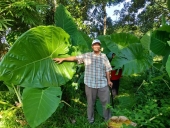I found a couple posts on the internet last night that talked about Burdock being able to grow in
hay bales making it easy to harvest the root. I was thinking maybe some
pallets set up in a drainage area I have between my big
pond and two other of my ponds.
Set the pallets up 4 feet high and fill 2 to 3 feet with hay and top off the rest with good soil. Make the structure 10 feet x 10 feet maybe and one burdock to each square foot for 100 plants. Make a 5 foot long 3 inch diameter sharpened
wood pole and drive through the soil/hay to make a 4 foot deep hole and fill it with some loamy soil/sand mixed. Plant my burdock in the tops of those soil filled holes.
My theory is that I should be able to remove a bunch of the hay between the plants and pull the root without too much removal or trouble. Watering should not be too much issue as the spring
water should wick into the lower half of the hay and slowly dry out as the summer goes on.
As for seed I harvested 8 plants from beside my front porch and beside my house that were all 9 to 10 feet tall and 5 to 6 feet wide. I have about a 25 pound bag of seed heads at the moment a 50 pound dog food bag 4/5ths full and packed. I collected roughly 3,500 seed heads and still have another 500 to 1,000 or so seed heads that still had slight green to them so I will wait to harvest those. I have found an average of 91 seeds per seed head so far so I should have just over 360,000 seeds collected or about right about 8 pounds of seed at the estimated 45,000 seeds per pound.
Turns out the wife is not a great fan of my burdock being next to the walkway and house and I was wanting to expand my
project anyways, so the obvious next step is a small garden for them. For my future seed needs I am going to go ahead and plant some burdock in my South Western forest where it is well away from people and animals. That will be more popular with the wife.

 3
3




 2
2





 2
2




 5
5




 4
4














 3
3




 3
3




 1
1




 1
1





 5
5





 I think if you have enough volume, then separating out the seeds will get easier - it doesn't matter if there is a bit of fluff if you are not selling the seed anyhow.
I think if you have enough volume, then separating out the seeds will get easier - it doesn't matter if there is a bit of fluff if you are not selling the seed anyhow.


